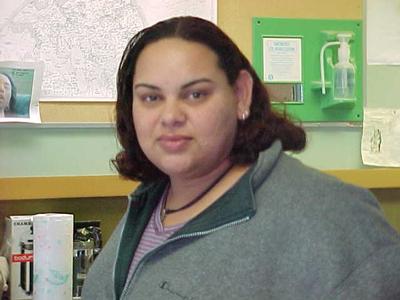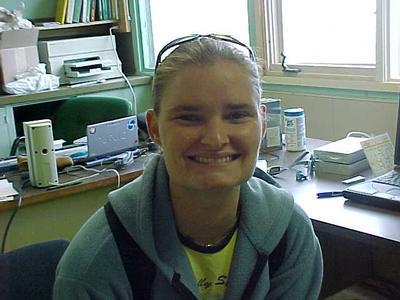5 June, 2001
Tuesday
Arrived in Barrow last night at 6:30 pm. The three (3) legs of the trip
from Tucson went smoothly but clouds blocked much of the view, especially
from Fairbanks to Barrow. The breaks in the clouds provided my first view
of the arctic tundra. Snow is still on the ground and the Arctic Ocean is
also still frozen although I could see puddles starting to form and ice
breaking up. My first impression of Barrow..muddy! The combination of
spring thaw and dirt roads makes for dirty cars, dirty boots and slippery
footing.
The team I'm with from San Diego State, is headed by Glen Kinoshita and
includes Spring Strahm and myself. More team members are expected up here
in the next few weeks. There are also two SDSU science educators, Ali Rios
and Maggie Reibold, who are here working in the elementary summer school
programs in town. We are still unpacking equipment and getting things
organized, which may take another day or two.
The weather was foggy all day and in the 30's. Glen and Spring had planned
to fly to Atqasuk this morning, a small village about 100 miles south of
Barrow, which houses another of the meteorological towers (eddy covalence
towers) we are monitoring. They were not able to because of the weather and
now plan to take the trip Friday. A lesson learned early for me is that the
weather rules what gets done many times up here in the Arctic.
Since we are in Barrow, a town of approx 4,000 people, our field camp is
not as rough and rustic as one might expect. We are headquartered at NARL
(Navy Arctic Research Laboratory) a facility which houses the local
Ilisagvik Junior College during the winter so we do have dorm type rooms, a
cafeteria which serves 3 meals a day, hot showers and a laundry room, all
the comforts of home! There are also other scientific teams here from other
universities. There are teams from U of Michigan, UCLA and U. of Maryland
each doing research on their own research so there are many people to talk
to and meet. People will be coming and going all summer so alot is
happening here all the time.
We visited the NOAA climate monitoring station today and had a tour of the
facility. It is small but packed with equiptment which records everthing
from wind speed and direction to the breakdown and identification of gases
in the air. Dan Endres, the Station Chief, explained the instruments and
what they record. The station sits back from the ocean front about a mile
and is close to one of our sites which Glen went to today to download data
from. Most all the sites are computer operated and are visited to collect
data which is then downloaded to the computers in the lab. Tomorrow we
start digging out and exposing the tundra plots to sunlight . They are
covered by snow, which would eventually melt but we are speeding up the
process in order to start exposing the tundra to light and start taking
diurnal measurements.
The remainder of the day was spent around Barrow, getting familiar with the
town. Where do you get gas for the vehicles? (there is one gas station in
town and gas is $3.55 per gallon.) Where do you buy food? There is one big
store in , S.P., which sells everything but I hope I don't have to use it
very often. Prices are very high up here because the supplies come up by
boat and only in the summer when the ice melts. Milk sells for $8.00 a
gallon, a coke 6 pack for $8.00...on sale! Salaries are higher also but
things are expensive.

Ali Rios, science educator from SDSU, who has been up to Barrow 4 times in the last year! She is now here teaching elementary summer school till mid June.

Maggie Reibold , science educator from SDSU, who is up here with us in Barrow and who is also teaching elementary summer school. Both she and Ali have their own web site with their experiences. Check it out to see Barrow's Elementary school and the students who live here. www.sdsa.org/Pisces/arctic_science/summer_2001/main.html

Looking south from the NARL Hotel (our dorm). You can see the tundra being exposed in places. The weather is warming and every day we notice a little more ground exposed.

Home sweet home for the next two months, and we all love it!

Spring Strahm, an undergrad researcher from SDSU, who will be working with me through July. This is her first trip to Barrow also and we will be learning the ropes together.
Contact the TEA in the field at
.
If you cannot connect through your browser, copy the
TEA's e-mail address in the "To:" line of
your favorite e-mail package.
|
